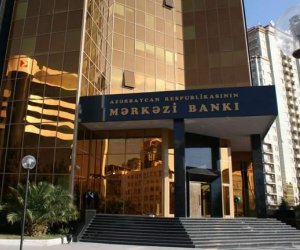Fitch Affirms 2 Azerbaijani Banks

Fitch Ratings has affirmed Azerbaijan-based Expressbank's (EB) Long-Term Issuer Default Rating (IDR) of at 'B' with a Stable Outlook. The agency has also affirmed Atabank's (AB) Long-Term IDR at 'B-' and removed it from Rating Watch Negative (RWN). A Negative Outlook has been assigned.
A full list of rating actions is available at the end of this rating action commentary.
KEY RATING DRIVERS
The affirmation of the banks' ratings reflects only a moderate worsening of EB's credit profile amid a challenging economic environment and the already low rating level of AB, which makes it tolerant to a more acute worsening of its metrics.
AB is rated one notch lower than EB to reflect its lower loss-absorption capacity, as a result of weaker pre-impairment profitability and a modest capital buffer, relative to the amount of unreserved non-performing loans (81% of the Fitch Core Capital (FCC) at end-2015). Exposure to foreign currency lending is also higher in AB (54% of loans at end-1Q16) than in EB (below 30% at end-1H16).
The ratings continue to reflect the banks' vulnerable earnings and asset quality (less so in EB), significant exposure to related parties and limited domestic franchises.
The Stable Outlook on EB reflects Fitch's expectation that the bank will be able to absorb credit losses through earnings without them eating into capital. The Negative Outlook on AB reflects higher asset quality risks, which given the small profitability and capital buffers, may erode the bank's capital base unless it is replenished by the shareholders.
EB
EB's corporate loan book (55% of gross loans at end-1H16) mostly consists of exposures to the bank's main corporate shareholder and its subsidiaries (92% of FCC), including a large construction company, engaged in infrastructure construction, and to a start-up diversified production plant, the development of which is actively supported by the government.
Although the related-party exposures are reportedly performing, there are sizeable grace periods on the interest and principal. However, credit risks in corporate lending are mitigated by (i) these companies directly or indirectly benefiting from the state contracts, (ii) generally adequate financial profiles, albeit weakened by 2015 manat devaluation, and (iii) solid capital buffer, which has been generally larger than the related-party exposures.
Retail non-performing loans (90 days overdue; NPLs) spiked to 20% of total retail loans at end-1H16 from 11% at end-2015 and 2.5% at end-2014, although these were fully covered by impairment reserves. The annualised NPL origination ratio (defined as increase in NPLs plus write-offs divided by average performing loans) was also high at 20% in 1H16, while retail pre-provision operating profit was only about 16% of retail loans. This means the bank needs to significantly improve retail loan quality to achieve break-even in 2016, which is challenging in Fitch's view.
EB's capital position is robust as expressed by a high 48% FCC ratio (defined as FCC/FCC-adjusted risk-weighted assets) at end-1H16. Near-term loan growth potential is limited, and capital ratios are unlikely to significantly decrease in the next couple of years. However, Fitch views EB's capital position in the context of the bank's sizeable related party lending (92% of FCC at end-1H16).
EB is funded by customer deposits (77% of total liabilities at end-1H16) and liquidity risks are mitigated by a sizeable liquidity buffer, which was sufficient to repay 31% of customer funding at end-1H16, and by a fast retail loan turnover. Wholesale funding (17% of end-1H16 liabilities) is mostly short-term and sourced domestically. Near-term refinancing needs equalled to AZN19m (13% of end-1H16 liabilities). Although EB's funding raised from related parties was negligible at end-1H16, there were some large deposits from companies considered as friendly to the bank's shareholders.
ATABANK
The affirmation of AB and resolution of RWN follows Fitch's assessment of the bank's capital position post-manat devaluation. The Negative Outlook reflects deterioration of the bank's credit profile in the form of increased unreserved NPLs to AZN43m (81% of FCC) at end-2015 from AZN16m (27%) at end-2014, which may erode equity unless rectified by new injections. According to the bank's management the bank's shareholders plan to inject new equity by end-2016, which, if completed, may help address AB's current asset quality issues.
AB's asset quality deteriorated sharply in 2015-1Q16, with NPLs increasing to 16% of gross loans at end-1Q16 from 6% at end-2014 due to a weaker economic environment. AB's NPLs were only 27% covered by impairment reserves at end-1Q16 and their additional provisioning could erode the bank's capital position. Loans to related parties accounted for a significant 26% of gross loans at end-2015, but they were mostly covered by pledged deposits.
At end-2015 AB's FCC ratio equalled to a moderate 11.6%, although this should be viewed against the bank's significant unreserved NPLs and weak core earnings. Fitch estimates that at end-2015 the bank's regulatory capital would allow reserving of only around 20% of these unreserved NPLs.
Internal capital generation capacity is also weak. Pre-impairment profit (PIP) net of non-recurring gains was only about AZN13m (2.7% of average gross loans) in 2015, while earning quality is questionable as 22% of interest was not received in cash.
AB's liquidity profile has deteriorated rather significantly due to funding outflows in 4Q15-1H16. Although funding outflows have mostly abated, at end-1H16 the bank's total available liquidity net of potential debt repayments equalled to a low 5.4% of customer accounts. This is particularly weak in light of the bank's rather concentrated customer funding and largely long-term nature of the bank's corporate book.
On 24 December 2015, Fitch placed AB's ratings on RWN due to the risk of material erosion of its loss absorption capacity following the devaluation of the manat (see 'Fitch Keeps IBA on RWP; Takes Negative Action on 4 Other Azerbaijani Banks' on www.fitchratings.com). Since the RWN, AB has avoided reporting FX losses. However, the negative developments in the bank's profile described above warranted the Negative Outlook.
KEY RATING DRIVERS - SUPPORT RATINGS AND SUPPORT RATING FLOORS (SRF)
The SRFs of 'No Floor' and Support Ratings of '5' for both banks reflect their limited scale of operations and market share. Although Fitch expects some regulatory forbearance to be available for these banks, in case of need, any extraordinary direct capital support from the Azerbaijan authorities cannot be relied upon, in the agency's view. The potential for support from banks' private shareholders is not factored into the ratings.
RATING SENSITIVITIES
Positive rating action for EB is contingent on substantial franchise development through growth of third-party business, a reduction in volume of operations with affiliated parties and moderation of downside asset quality risks.
Negative rating actions could be triggered by significant asset quality deterioration resulting in considerable impairment losses exceeding pre-impairment profit and eroding capital (more likely in AB) unless this is addressed by new capital injections. Negative rating pressure for AB could also stem from a further liquidity squeeze. Conversely, if AB receives new capital injection and asset quality pressure recedes, the Outlook may be revised to Stable.
Fitch believes that positive rating actions on the banks' SR and SRFs are unlikely in the near-term.
www.ann.az
A full list of rating actions is available at the end of this rating action commentary.
KEY RATING DRIVERS
The affirmation of the banks' ratings reflects only a moderate worsening of EB's credit profile amid a challenging economic environment and the already low rating level of AB, which makes it tolerant to a more acute worsening of its metrics.
AB is rated one notch lower than EB to reflect its lower loss-absorption capacity, as a result of weaker pre-impairment profitability and a modest capital buffer, relative to the amount of unreserved non-performing loans (81% of the Fitch Core Capital (FCC) at end-2015). Exposure to foreign currency lending is also higher in AB (54% of loans at end-1Q16) than in EB (below 30% at end-1H16).
The ratings continue to reflect the banks' vulnerable earnings and asset quality (less so in EB), significant exposure to related parties and limited domestic franchises.
The Stable Outlook on EB reflects Fitch's expectation that the bank will be able to absorb credit losses through earnings without them eating into capital. The Negative Outlook on AB reflects higher asset quality risks, which given the small profitability and capital buffers, may erode the bank's capital base unless it is replenished by the shareholders.
EB
EB's corporate loan book (55% of gross loans at end-1H16) mostly consists of exposures to the bank's main corporate shareholder and its subsidiaries (92% of FCC), including a large construction company, engaged in infrastructure construction, and to a start-up diversified production plant, the development of which is actively supported by the government.
Although the related-party exposures are reportedly performing, there are sizeable grace periods on the interest and principal. However, credit risks in corporate lending are mitigated by (i) these companies directly or indirectly benefiting from the state contracts, (ii) generally adequate financial profiles, albeit weakened by 2015 manat devaluation, and (iii) solid capital buffer, which has been generally larger than the related-party exposures.
Retail non-performing loans (90 days overdue; NPLs) spiked to 20% of total retail loans at end-1H16 from 11% at end-2015 and 2.5% at end-2014, although these were fully covered by impairment reserves. The annualised NPL origination ratio (defined as increase in NPLs plus write-offs divided by average performing loans) was also high at 20% in 1H16, while retail pre-provision operating profit was only about 16% of retail loans. This means the bank needs to significantly improve retail loan quality to achieve break-even in 2016, which is challenging in Fitch's view.
EB's capital position is robust as expressed by a high 48% FCC ratio (defined as FCC/FCC-adjusted risk-weighted assets) at end-1H16. Near-term loan growth potential is limited, and capital ratios are unlikely to significantly decrease in the next couple of years. However, Fitch views EB's capital position in the context of the bank's sizeable related party lending (92% of FCC at end-1H16).
EB is funded by customer deposits (77% of total liabilities at end-1H16) and liquidity risks are mitigated by a sizeable liquidity buffer, which was sufficient to repay 31% of customer funding at end-1H16, and by a fast retail loan turnover. Wholesale funding (17% of end-1H16 liabilities) is mostly short-term and sourced domestically. Near-term refinancing needs equalled to AZN19m (13% of end-1H16 liabilities). Although EB's funding raised from related parties was negligible at end-1H16, there were some large deposits from companies considered as friendly to the bank's shareholders.
ATABANK
The affirmation of AB and resolution of RWN follows Fitch's assessment of the bank's capital position post-manat devaluation. The Negative Outlook reflects deterioration of the bank's credit profile in the form of increased unreserved NPLs to AZN43m (81% of FCC) at end-2015 from AZN16m (27%) at end-2014, which may erode equity unless rectified by new injections. According to the bank's management the bank's shareholders plan to inject new equity by end-2016, which, if completed, may help address AB's current asset quality issues.
AB's asset quality deteriorated sharply in 2015-1Q16, with NPLs increasing to 16% of gross loans at end-1Q16 from 6% at end-2014 due to a weaker economic environment. AB's NPLs were only 27% covered by impairment reserves at end-1Q16 and their additional provisioning could erode the bank's capital position. Loans to related parties accounted for a significant 26% of gross loans at end-2015, but they were mostly covered by pledged deposits.
At end-2015 AB's FCC ratio equalled to a moderate 11.6%, although this should be viewed against the bank's significant unreserved NPLs and weak core earnings. Fitch estimates that at end-2015 the bank's regulatory capital would allow reserving of only around 20% of these unreserved NPLs.
Internal capital generation capacity is also weak. Pre-impairment profit (PIP) net of non-recurring gains was only about AZN13m (2.7% of average gross loans) in 2015, while earning quality is questionable as 22% of interest was not received in cash.
AB's liquidity profile has deteriorated rather significantly due to funding outflows in 4Q15-1H16. Although funding outflows have mostly abated, at end-1H16 the bank's total available liquidity net of potential debt repayments equalled to a low 5.4% of customer accounts. This is particularly weak in light of the bank's rather concentrated customer funding and largely long-term nature of the bank's corporate book.
On 24 December 2015, Fitch placed AB's ratings on RWN due to the risk of material erosion of its loss absorption capacity following the devaluation of the manat (see 'Fitch Keeps IBA on RWP; Takes Negative Action on 4 Other Azerbaijani Banks' on www.fitchratings.com). Since the RWN, AB has avoided reporting FX losses. However, the negative developments in the bank's profile described above warranted the Negative Outlook.
KEY RATING DRIVERS - SUPPORT RATINGS AND SUPPORT RATING FLOORS (SRF)
The SRFs of 'No Floor' and Support Ratings of '5' for both banks reflect their limited scale of operations and market share. Although Fitch expects some regulatory forbearance to be available for these banks, in case of need, any extraordinary direct capital support from the Azerbaijan authorities cannot be relied upon, in the agency's view. The potential for support from banks' private shareholders is not factored into the ratings.
RATING SENSITIVITIES
Positive rating action for EB is contingent on substantial franchise development through growth of third-party business, a reduction in volume of operations with affiliated parties and moderation of downside asset quality risks.
Negative rating actions could be triggered by significant asset quality deterioration resulting in considerable impairment losses exceeding pre-impairment profit and eroding capital (more likely in AB) unless this is addressed by new capital injections. Negative rating pressure for AB could also stem from a further liquidity squeeze. Conversely, if AB receives new capital injection and asset quality pressure recedes, the Outlook may be revised to Stable.
Fitch believes that positive rating actions on the banks' SR and SRFs are unlikely in the near-term.
www.ann.az
Similar news
Similar news




































 Photo
Photo 



 Video
Video 

